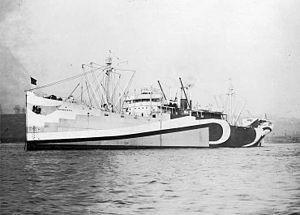Design 1025 ship
 USS Newburgh (1918) | |
| Class overview | |
|---|---|
| Name | EFT Design 1025 |
| Builders | Merchant Shipbuilding Corporation Newburgh Shipyards Pensacola Shipbuilding Company |
| Built | 1919–1920 (USSB) |
| Planned | 62 |
| Completed | 62 |
| General characteristics | |
| Type | Cargo ship |
| Tonnage | 9,000 dwt |
| Length | 410 ft 5 in (125.10 m) |
| Beam | 54 ft 0 in (16.46 m) |
| Draft | 29 ft 9 in (9.07 m) |
| Propulsion | Two turbines, oil fuel |
The Design 1025 ship (full name Emergency Fleet Corporation Design 1025) was a steel-hulled cargo ship design approved for production by the United States Shipping Board's Emergency Fleet Corporation (EFC) in World War I.[1] They were referred to as the "Harriman-type" as the majority of ships were built in the Harriman section of Bristol, Pennsylvania.[1] A total of 62 ships were ordered and built at three shipyards: 40 ships at Merchant Shipbuilding Corporation, Bristol, Pennsylvania; 12 ships at Newburgh Shipyards in Newburgh, New York; and 10 ships at Pensacola Shipbuilding Company in Pensacola, Florida.[1][2][3][4]
References
- ^ a b c McKellar, p. Part III, 137-139.
- ^ Colton, Tim (October 21, 2013). "Merchant Shipbuilding, Bristol PA". shipbuildinghistory.com. Retrieved 12 July 2021.
- ^ Colton, Tim (March 11, 2016). "Newburgh Shipyards, Newburgh NY". shipbuildinghistory.com. Retrieved 12 July 2021.
- ^ Colton, Tim (November 30, 2016). "Pensacola Shipbuilding, Pensacola FL - Smith's Shipyard, Pensacola FL". shipbuildinghistory.com. Retrieved 12 July 2021.
Bibliography
- McKellar, Norman L. "Steel Shipbuilding under the U. S. Shipping Board, 1917-1921, Part III, Contract Steel Ships" (PDF). Steel Shipbuilding under the U. S. Shipping Board, 1917-1921. ShipScribe. Retrieved 13 February 2021.
